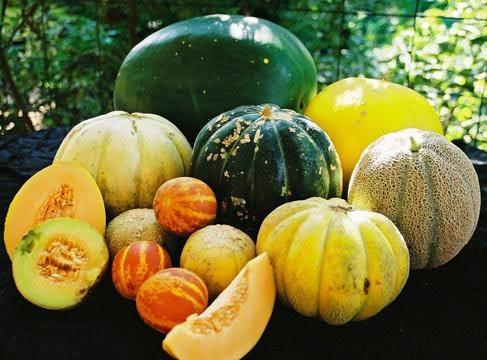
3 minute read
EDIBLEharvest
Melon Timing
By Barbara Melera
I was eating the last of the June strawberries as I wrote this. They were the most beautiful strawberries I had ever seen—so beautiful, in fact, that they almost didn’t look real. However, it wasn’t their beauty that was their greatest asset. It was their incredible sweetness. They were the inspiration for this column: As I sat savoring their flavor, I started thinking about fruit that needs no sweetening and immediately melons came to mind. I grew up living through each summer on a diet of homegrown tomatoes and melons purchased from various men who drove melon-laden, horse-drawn carts down the alleys of Baltimore City yelling, “Melons for sale. Get your sweet melons!” It is a multi-dimensional memory of flavor, fragrance, texture, and intense color that I will never forget.
Don’t Sow Them Too Early
This is also a column about direct-sown varieties that are nearly always planted too early and therefore encounter problems that they ordinarily should not. These direct-seeded varieties are summer squash and melons. Today, the common practice with melons is to purchase seedlings in May and plant the seedlings in mid to late May. This was not the practice 100 years ago, nor is it the practice among some traditional farming cultures. Melons do best when planted from seed in warm soil. They produce stronger plants and sweeter fruit when planted late. In USDA hardiness zones 4–7, I recommend that you start your melons from seed in your garden in early to mid-June. You will be surprised to find that the melons you start from seed in June will produce fruit just as quickly as the melon seedlings you planted in May.
How to Grow Melons
Melons require a long, hot, dry growing season of 80–120 days, with some watermelons requiring 150 days. Melons like 60-degree nights and 80degree days, and will not tolerate frost. They prefer sandy loam soil that is slightly alkaline. Each year, rotate melons and watermelons to different sites in the garden to prevent damage from nematodes or Fusarium. Melon seeds planted in cold soil tend to germinate very slowly and if the cold soil is wet or even moist, the melon seeds frequently become moldy or rot. Before planting melon seeds, mix generous quantities of compost or organic fertilizer into the soil. Melons and watermelons grow best when their garden patch is covered with 6 mm black polyethylene plastic. Even though the plastic looks ugly, it keeps the soil warm, conserves moisture, slows weeds, avoids the disruption that results from weeding, and keeps plants clean and free of rot. Plant six to eight melon seeds 1 inch deep, in hills approximately 6–8 inches high and 2 feet in diameter. When the plants are 2 inches tall, thin the seedlings to three to four plants per hill, 12 inches apart, with hills spaced 4 feet apart. Fertilize young plants with fish or seaweed emulsion. As the vines begin to set fruit, fertilize every two weeks with a high-phosphorous, high-potassium fertilizer like Espoma’s TomatoTone. Melons and watermelons need a consistent supply of water until the fruits are roughly the size of baseballs. After this, do not water unless drought conditions exist. Depriving the plant of water encourages ripening and makes the flesh sweeter and more flavorful. When it is time to harvest, many melons slip from the vine, sound hollow when rapped with a fist, or give off an intensely sweet fragrance. The right conditions change from climate to climate and season to season. The best way to gauge when it is time to harvest is to take a melon and try it.
Melons in Containers
To grow melons in a container, fill an 18-inch pot with a soil mix that is 60% topsoil, 20% dehydrated manure, and 20% peat moss. Make holes in the soil with a pencil and drop individual melon seeds in each hole. Plant six to eight seeds per pot. Fill the holes with soil and water the pot generously. When the seedlings are 2 inches tall, thin them out, leaving three plants per pot. Melons planted in containers must be fertilized each week with a highphosphorus, high-potassium fertilizer or a blossom booster fertilizer until fruit has set. Once the fruit has set, fertilize every two weeks.
I urge you all, try some melons this year. Their sweetness can beat out those strawberries I just finished. o
Barbara Melera is the president of Harvesting History (www.harvesting-history.com), a company founded in 2016 to provide horticultural and agricultural products, largely of the heirloom variety, along with garden tools and equipment.










